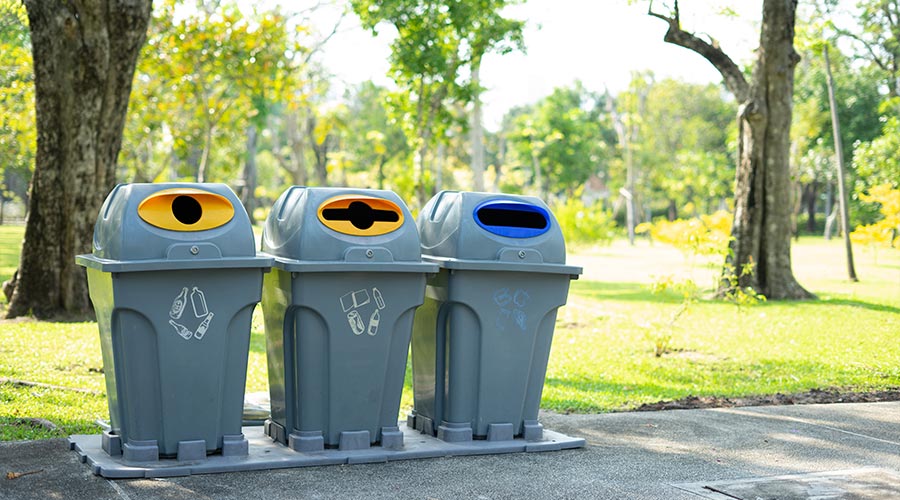
With a range of customers — from manufacturing facilities to schools and colleges, retail and office buildings, hospitals and restaurants, entertainment and recreational venues, and more — there is a wide variety of types of waste, as well as volume, generated on a regular basis. Sustainability initiatives may already be part of the fabric of some customers' operations, while others may find meeting state and local regulations or even their own sustainability goals bothersome. Flexibility in designing workable programs and supplying the equipment and materials for waste diversion efforts for different customers is crucial.
“Some industries are naturally set up for success when it comes to waste diversion,” says Reyna. “Manufacturing and distribution, for example, generate large amounts of consistent waste like wood pallets, cardboard, and mixed metals, making it easier to separate and recycle materials on the back end.”
Meanwhile, in her experience, “universities and corporate offices tend to have strong sustainability initiatives in place, so waste diversion aligns well with their existing goals.”
Reyna says that large office spaces and sporting venues can be more challenging because of the variety of waste they generate and the fast-paced nature of their operations.
“Contamination is a big issue in these environments,” she says. “People often toss the wrong items into the wrong bins, which can derail even the best recycling efforts. That’s why education is critical. If employees and customers don’t understand the system, even the most well-designed waste diversion program won’t be successful.”
Regardless of the type of business or facility, “waste diversion programs truly come down to training and implementation,” Cummins adds
Consider the Cost
With a waste audit complete and equipment and a collection system designed or already in place, there still may be pushback from customers on the cost and time commitment involved in establishing new procedures or following new or changing regulations. Talking through concerns with customers can be crucial to a successful implementation.
“Many times, customers will wait until the very last minute to make a change,” Cummins says. “There can be a large cost associated with any of the changes passed down by government, and many don’t want to make the investment until they absolutely need to. With that being said, I emphasize helping end user customers understand the laws, and training and guiding them through the program, all of which can make it much easier.”
Reyna also sees pushback from customers concerned about the cost of recycling and waste diversion programs.
“A common misconception is that waste diversion is too expensive,” she says. “In reality, businesses can often save money by reducing landfill waste and finding better ways to handle materials. If leadership only looks at the upfront cost of bins and training without considering the long-term savings, they can be hesitant to commit. That’s when we show them the numbers and how waste reduction improves their bottom line.”
Reyna shared a favorite example of how pushing back in a positive way worked both for her company and for her customer.
“Initially, during a collaborative meeting between Verde and one of our large manufacturing customers, they planned to place individual trash and recycling bins at every workstation in their new, 700,000-square-foot facility,” she explains. “Instead, we proposed a centralized trash system, where individual desk bins were removed in favor of communal waste stations. This simple shift not only improved waste separation — ensuring recyclables stayed out of the landfill — but also led to major cost savings. The client saved $110,000 in start-up costs, diverted nearly a million plastic liners from landfills annually, and reduced ongoing waste management costs by $152,000 per year. It’s proof that a well-designed program doesn’t have to be complicated — it just has to make sense for the people using it,” she says.
This example of being able to provide comparisons of before and after the implementation of waste reduction measures provides a clear picture of the impact for customers. This information is vital for quantifying the direct benefits, such as a decrease in waste production and lower disposal costs. It highlights the effectiveness of sustainable practices and reinforces the value of environmental stewardship.
Maintaining Relationships
Sustainability matters. Proactively working with clients to achieve their sustainability goals and satisfy regulations or guiding them towards developing and implementing waste management systems, is good business. Distributors should do so with the customer in mind.
“What doesn’t work is assuming people will just 'figure it out,'” emphasizes Reyna. “If a company installs bins without proper guidance, they’ll end up with a mess; contaminated recycling, wasted efforts, and a frustrated team. Waste diversion has to be intentional. It takes education, commitment, and a little bit of creativity to make it successful.”
Cummins agrees, adding that Imperial Dade emphasizes a good, better and best concept for customers.
“We always offer a variety of options for the customer,” she says. “If you just tell them the law and don’t show them options, it makes the task seem larger than what it is.”
In addition to products, experts emphasize the importance of outlining a manageable process for customers.
“Waste diversion isn’t about doing everything perfectly. It’s about making progress,” Reyna adds. “The companies that succeed aren’t the ones with the most elaborate programs. We’ve found that companies with the most successful waste diversion programs are the ones that take small, consistent steps in the right direction. It’s all about making sustainability practical, achievable, and rewarding.”
By serving as a reliable resource and having thorough knowledge of and giving input on state and local regulations, guiding customers through waste audits, providing training and ongoing support for implementation of recycling and waste diversion systems, and offering workable options for those systems themselves, distributors can play a crucial role in helping their clients achieve their sustainability goals, save money, and reduce their environmental impact.
Shannon O'Connor is a freelance writer based in Mason, Ohio.
Prioritize Sustainability in Waste Management Strategies

 The Down and Dirty on Cleaning in Virus Season
The Down and Dirty on Cleaning in Virus Season How Surfactant Use is Expanding in Commercial Cleaning
How Surfactant Use is Expanding in Commercial Cleaning